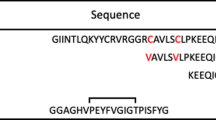Abstract
Ostricacin-1 and ostricacin-2 (Osp-1 and Osp-2) were β-defensins antimicrobial peptides that were purified from ostrich leukocytes using a cation-exchange column and a semi-prep RP-HPLC column. Both ostricacins were subjected to increased concentrations of monovalent cations (K+ and Na+) and divalent cations (Ca2+ and Mg2+) in order to investigate the effect of cations on the activity of these ostricacins on Gram-negative bacteria and Gram-positive bacteria. The radial diffusion assay method showed that both ostricacins were sensitive to the presence of cations. The divalent cations showed more antagonized effect on the activity against Gram-negative bacteria than the monovalent cations, as the ostricacins lost ability to inhibit bacterial growth at very low concentration (5 mM). When viewed in the context of other defensins activity, our data support a hypothesis that defensins’ overall net positive charge determine the sensitivity to cations.





Similar content being viewed by others
Literature Cited
Anderson RC, Yu P-L (2005) Factors affecting the antimicrobial activity of ovine-derived cathelicidins against E. coli O157:H7. Int J Antimicrob Agent 25:205–210
Bals R, Goldman MJ, Wilson JM (1998) Mouse β-defensin-1 is a salt–sensitive antimicrobial peptide present in epithelial of the lung and urogenital tract. Infect Immun 66:1225–1232
Bals R, Want X, Wu Z, Freeman T, Bafna V, Zasloff M, Wilson JM (1998) Human β-defensin-2 is a salt-sensitive peptide antibiotic expressed in human lung. J Clin Invest 102:874–880
Epand RM, Vogel HJ (1999) Diversity of antimicrobial peptides and their mechanisms of action. Biochim Biophys Acta 1462:11–28
Evans EW, Harmon BG (1995) A review of antimicrobial peptides: defensins and related cationic peptides. Vet Clin Pathol 24:109–116
Friedrich CF, Scott MG, Karunaratne N, Yan H, Hancock REW (1999) Salt-resistant alpha-helical cationic antimicrobial peptides. Antimicrob Agents Chemother 43:1542–1548
Ganz T (2005) Defensins and other antimicrobial peptides: a historical perspective and an update. Comb Chem High Throughput Screen 8:209–217
Goldman MJ, Anderson GM, Stolzenberg ED, Kari UD, Zasloff M, Wilson JM (1997) Human β-defensin-1 is a salt-sensitive antibiotic in lung that is inactivated in cystic fibrosis. Cell 88:553–560
Hancock REW, Diamond G (2000) The role of cationic antimicrobial peptides in innate host defences. Trends Microbiol 8:402–410
Harder J, Bartels J, Christophers E, Schröder JM (2001) Isolation and characterization of human β-defensin-3, a novel human inducible peptide antibiotic. J Biol Chem 276:5707–5713
Landon C, Thouzeau C, Labbe H, Bulet P, Vovelle F (2004) Solution structure of spheniscin, a β-defensin from the penguin stomach. J Biol Chem 279:30,433–34,039
Lehrer RI, Ganz T (2002) Defensins of vertebrate animals. Curr Opin Immunol 14:96–102
Lehrer RI, Rosenman M, Harwig SSL, Jackson R, Eisanhauer PB (1991) Ultrasensitive assays for endogenous antimicrobial peptides. J Immunol Methods 137:167–173
Lynn DJ, Higgs R, Lloyd AT, Hervé-Grépinet V, Nys Y, Brinkman FS, Yu PL, Soulier A, Kaiser P, Zhang G, O’Farrelly C, Lehrer RI (2007) Avian beta-defensin nomenclature: a community proposed update. Immunol Lett (in press)
Martin E, Ganz T, Lehrer RI (1995) Defensins and other endogenous peptide antibiotics of vertebrates. J Leuk Biol 58:128–136
Sang Y, Ortega MT, Blecha F, Prakash O, Melgarejo T (2005) Molecular cloning and characterization of three β-defensins from canine testes. Infect Immun 73:2611–2620
Steinberg DA, Lehrer RI (1997) Designer assays for antimicrobial peptides. Methods Mol Biol 78:169–186
Sugiarto H, Yu PL (2006) Identification of three novel ostricacins: an update on the phylogenetic perspective of β-defensins. Int J Antimicrob Agents 27:229–235
Torres AM, Kuchel PW (2004) The β-defensin-fold family of polypeptides. Toxicon 44:581–588
Turner J, Cho Y, Dinh NN, Waring AJ, Lehrer RI (1998) Activities of LL-37, a cathelin-associated antimicrobial peptide of human neutrophil. Antimicrob Agents Chemother 42:2206–2214
Yang D, Chertov O, Oppenheim JJ (2001) The role of mammalian antimicrobial peptides and proteins in awakening of innate host defenses and adaptive immunity. Cell Mol Life Sci 58:978–989
Yang D, Oppenheim JJ (2004) Multiple functions of antimicrobial peptides in host immunity. In DA Devine, REW Hancock (eds) Mammalian host defense peptides. Cambridge University Press, Cambridge, Pages 39–68
Zasloff M (2002) Antimicrobial peptides of multicellular organisms. Nature 415:389–395
Acknowledgments
This work was supported by Massey University Research Funds and the C. Alma Baker Trust Fund. We thank Dr. Charles Bevins for critical reading of the manuscript.
Author information
Authors and Affiliations
Corresponding author
Rights and permissions
About this article
Cite this article
Sugiarto, H., Yu, PL. Effects of Cations on Antimicrobial Activity of Ostricacins-1 and 2 on E. coli O157:H7 and S. aureus 1056MRSA. Curr Microbiol 55, 36–41 (2007). https://doi.org/10.1007/s00284-006-0554-z
Received:
Accepted:
Published:
Issue Date:
DOI: https://doi.org/10.1007/s00284-006-0554-z




